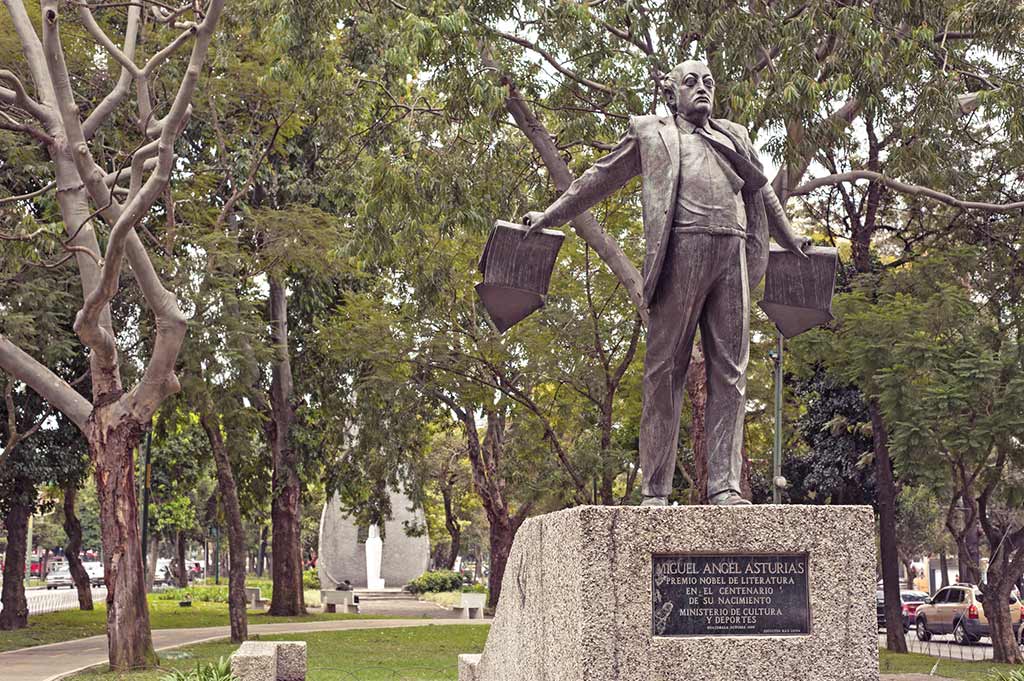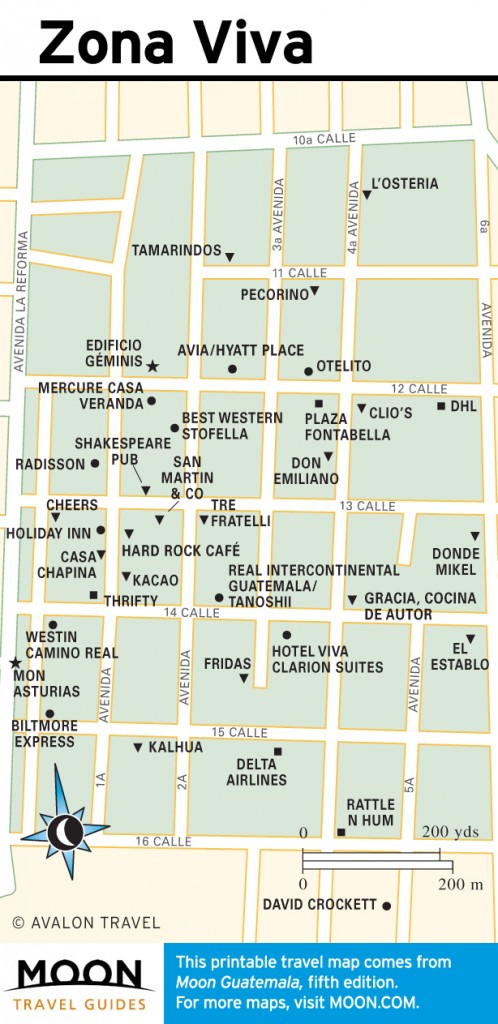Zona 10 is home to Guatemala City’s most pleasant commercial district, a beautiful example of 19th century architecture, and two excellent museums–one a definite must-see for anyone with even a passing interest in Mayan culture.
Running between 1a Calle and 20 Calle, Avenida La Reforma is a classic example of the 19th-century trend, common throughout Latin America’s major capitals, of emulating French architectural and urban design with wide, tree-lined boulevards adorned with statues. This broad thoroughfare separates Zonas 9 and 10 and features some of the city’s better hotels, cafés, and restaurants along its path. The wide, grassy median contains some interesting sculptures and makes a great place for a stroll or bike ride thanks to a new bike path running its entire length. La Reforma culminates at the spacious Parque Obelisco, featuring a large obelisk, a gigantic Guatemalan flag, palm trees, a fountain, and sitting areas.

A statue of Nobel Prize laureate Miguel Ángel Asturias on Avenida La Reforma. Photo © Al Argueta.

Zona Viva
Unlike in downtown Guatemala City, you’ll find plenty of trees sheltering the streets from the harsh tropical sun in addition to wide, pedestrian-friendly sidewalks. Zona Viva’s many high-rise buildings harbor banks, offices, the bulk of Guatemala City’s international hotel chain properties, and condominiums. None of these buildings is more than 20 stories high, as the airport’s proximity limits vertical expansion of the adjacent areas, giving the neighborhood a cosmopolitan feel without the claustrophobic concrete-jungle look found in larger international cities. Interspersed between office buildings are the area’s many dining and entertainment options and tucked away into the side streets are some of Guatemala’s nicest residences sheltered behind walls, barbed wire, and bougainvillea.
During the day, Zona Viva’s streets are mostly the haunt of businesspeople because of the area’s prominence as the city’s main financial district. By night, especially on weekends, it becomes the enclave of young folks heading to bars and nightclubs or dinner at a fancy restaurant. If you find yourself needing to spend a night or two in Guatemala City, you might make it a very enjoyable experience by checking into one of the area’s attractive boutique or international chain hotels, eating at one of the recommended local restaurants, and taking in one or several of the nearby museums. The recent addition of a hostel to the area’s accommodations means this is no longer just an option for wealthy travelers. It is also conveniently close to the airport.
![Museo Ixchel in Guatemala City. Photo © Clau.mrossal (Own work) [Public domain], <a href="https://commons.wikimedia.org/wiki/File%3AMuseo_Ixchel.JPG">via Wikimedia Commons</a>.](https://www.holidaytravel.cc/Article/UploadFiles/201602/2016021614552010.jpg)
Museo Ixchel in Guatemala City. Photo © Clau.mrossal (Own work) [Public domain], via Wikimedia Commons.
The city’s most magnificent museum, Museum Ixchel (6a Calle Final Zona 10, tel. 2361-8081/2, 9am-5pm Mon.-Fri., 9am-1pm Sat., $4 adults, $2 students, $15-80 for guided tours in English) on the grounds of the Francisco Marroquín University, is dedicated to Mayan culture with an emphasis on weaving and traditional costumes. It’s housed in a beautiful brick building built to resemble a Mayan huipil, or handwoven, embroidered blouse. On display are pre-Hispanic objects, photographs, handwoven fabrics, ceremonial costumes, weaving tools, and folk paintings by Guatemalan artist Andrés Curruchich. You’ll find interactive multimedia displays, a café, bookstore, and huipiles for sale in the excellent gift shop. Displays are in English and Spanish. This museum is a must-see for anyone with even a casual interest in Mayan weaving, as it manages to condense the country’s rich weaving heritage spanning a fairly vast geographical range into a single place with excellent displays and an attractive setting.Next door and also on the university campus is the similarly high-caliber Museo Popol Vuh (tel. 2361-2301, 9am-5pm Mon.-Fri., 9am-1pm Sat., $4 adults, $2 students). Started in 1978 with a university donation by private collectors, it has been in its current location since 1997. The museum houses an impressive collection from Guatemala’s archaeological record grouped in different rooms denoted by Preclassic, Classic, Postclassic, and Colonial themes. The highlight is in the Postclassic room with a replica of the Dresden Codex, one of only three Mayan books to survive their postconquest burning by the Spanish (the other two are the Paris Codex and the Madrid Codex).
Excerpted from the Fifth Edition of Moon Guatemala.